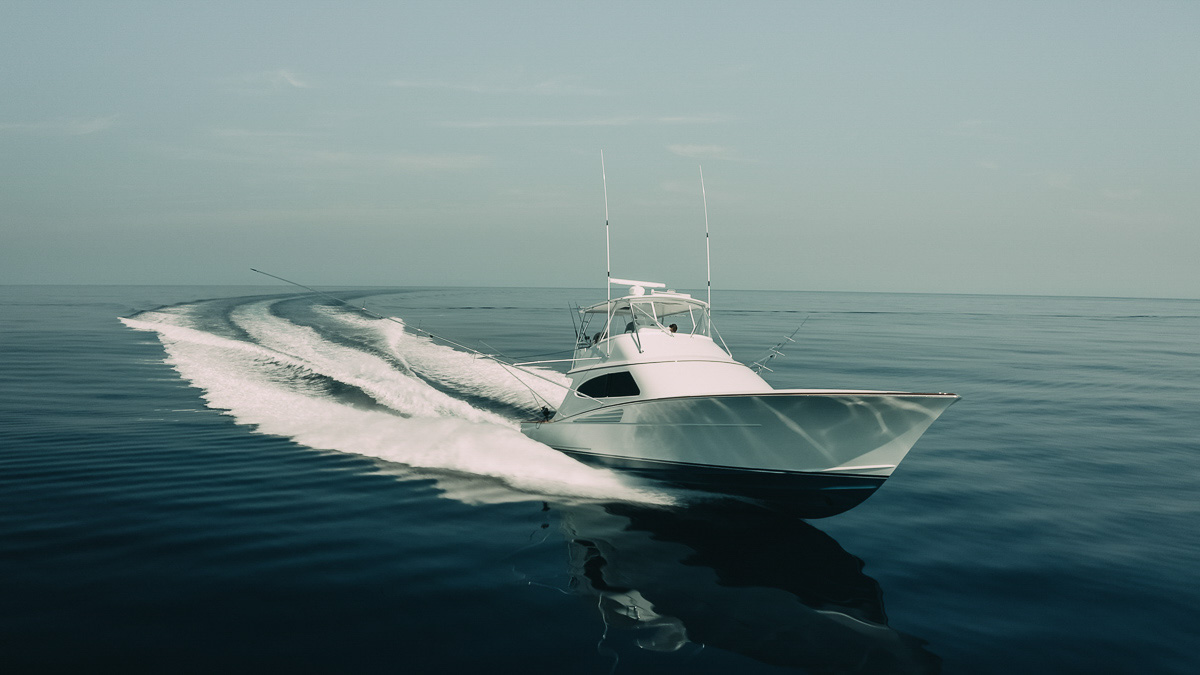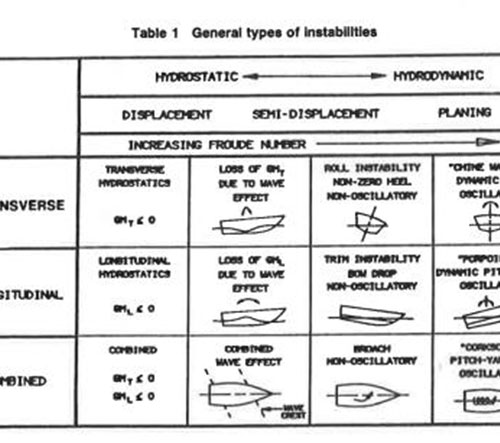DLBA UNIVERSITY
Dynamic Stability of Planing Boats
MAY 10, 2018
By Donald L. Blount and Louis T.Codega
High-speed craft have been known to lose stability while underway even though they possess adequate static stability. Dynamic instabilities have been reported in roll, pitch , and yaw, and include porpoising, chine walking, loss in running trim (diving), bow steering, progressive heeling to port or starboard, or a combination of motions. Instabilities can result in structural damage, loss of control, and crew injury.

The problem is not well understood and accepted guidelines do not exist which will ensure adequate dynamic stability. The authors report data for boats which exhibit nonoscillatory dynamic instabilities and suggest quantitative criteria which may result in development of dynamically stable planning boats. Experimental procedures are presented to indicate the potential for nonoscillatory instabilities for expected operating conditions.
In case you would like to receive the full paper or discuss about this subject, please contact Jeffrey Bowles.

References
1. Cohen, S.H. and Blount, D.L. “Research Plan for the Investigation of Dynamic Instability of Small High-Speed Craft,” SNAME transactions, Vol. 94, 1996.
2. Day, J.P. and Haag R.J. “Planing Boat Porpoising,” Thesis submitted to Webb Institute of naval Architecture, Glen Clove, N.Y., May 1952.
3. Savitsky, D. “Hydrodynamic Design of Planing Hulls,” Marine Technology, Vol. 1, Oct. 1964.
4. Martin, M.,“Theoretical Determination of Porpoising Instability of High Speed Planing Boats,” Journal of Ship Research, Vol. 22, No. 1, March 1978.
5. Du cane, P., High Speed Small Craft, David and Charles, Newton Abbot, U.K., 1974
6. Saunders, H.E., Hydrodynamics of ShipDesign, SNAME, 1957.
7. Clement, E. and Desty, D., “The BP Dynaplane High-Speed Research Boat,” High Speed Surface Craft Exhibition and Conference, High Speed Surface Craft Publishing Association, Middlesex, U.K., 1982.
8. Abott, I.H. and von Doenhoff, A.E. , Theory of Wing Sections, Dover Publications, New York, 1959.
9. Codega, L. and Lewis J., “A case Study of Dynamic Instability in a Planing Hull,” Marine Technology, Vol. 24, No. 2, April 1987.
10. Millward A., “Preliminary Measurements of Pressure Distribution to Determine the Traverse Stability of a Fast Round Bilge Hull,” International Shipbuilding Progress, Vol. 26, No. 297, May 1979.
11. Wakeling, B.P., Sproston, J.L., and Millward A., “Transverse Stability of a Fast Round Bilge Hull,” International Shipbuilding Progress, Vol. 29, No. 337, Sept. 1982.
12. Lefebre, P., “theoretical Considerations and User’s Manual for a Modifies XYZ Potential Flow program for Calculating Five Degree of Freedom Velocity Potentials,” Naval Underwear Systems Center, Newport Laboratory, technical memorandum, 82-2076A, Newport, R.I., Nov. 15, 1982.
13.K euning, J.A. and Gerritsma, P., “Resistance Tests of a Series of Planing Hull Forms with 25 Degrees Dead-rise Angle,” International Shipbuilding Progress, Vol. 29, No. 337, Sept. 1982.
14. Clement, E.and Blount, D., “Resistance Tests of a Systematic Series of Planing Hull Forms,” Transactions, Vol. 71, 1963.
15. Savitsky, D. and Ward Brown, P., “procedures for Hydrodynamic Evaluation of Planing Hulls in Smooth and Rough Water,” Marine Technology, Vol. 13,No. 4, Oct. 1976
Share this article online:
HOW CAN WE HELP YOU?
FEEL FREE TO CONTACT US

DLBA Naval Architects
860 Greenbrier Circle, Suite 201 Chesapeake, Virginia 23320 USA
Phone: 757-545-3700 | Fax: 757-545-8227 | dlba@gibbscox.com
STAY UPDATED
SIGN UP FOR OUR NEWSLETTER
Keep your finger on the pulse of the latest points of focus in naval architecture and engineering: subscribe to DLBA’s concise monthly newsletter. Within it, we briefly describe and picture our latest projects and concepts. We encourage feedback and seek to have our newsletter spark conversation regarding potential collaborations and further advancements as we share our passion for the industry.
